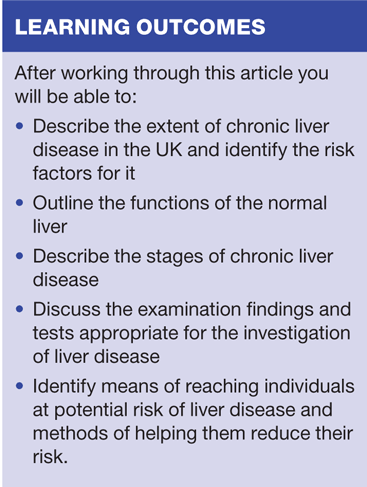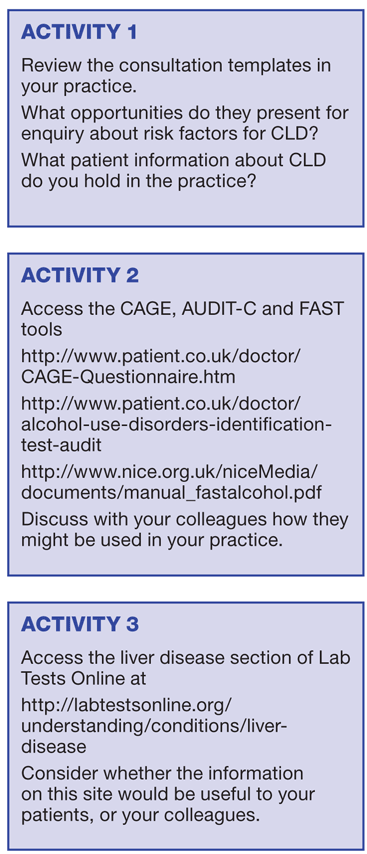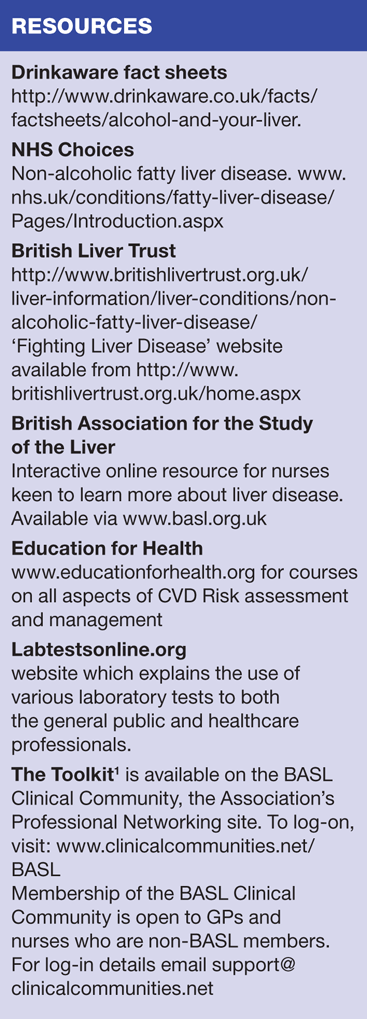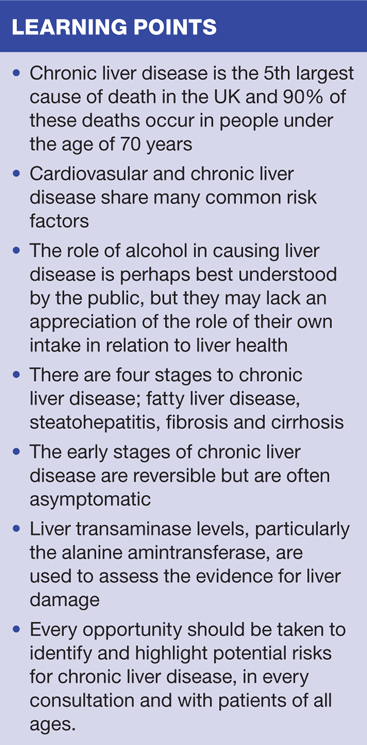Liver disease — what you need to know and what you need to do
Beverley Bostock-Cox
Beverley Bostock-Cox
RGN, BSc, MSc
Nurse Practitioner Sky Blue Medical Group Coventry & Mann Cottage Surgery Moreton in Marsh Clinical Lead Education for Health
Chronic liver disease is an increasing problem that is largely preventable but frequently overlooked in primary care. If we are to contribute to the reversal of this trend, practice nurses need to raise their awareness of both the disease and opportunities for intervention
Chronic liver disease (CLD) is the fifth largest cause of death in the UK1 and 90% of these deaths occur in people under the age of 70. Yet liver disease is often overlooked in primary care, despite the fact that it is largely preventable. Initiatives such as the NHS health check programme focus on the prevention of cardiovascular disease (CVD). However, since CVD and CLD share several of the same risk factors, such schemes give us an ideal opportunity to educate the public about the risks of developing CLD, as well as CVD. At the same time we should not forget that increasing numbers of young people are developing signs of liver disease. We therefore need to be alert to every opportunity to discuss risk factors for liver disease in all age groups. Opportunistic advice can be offered in travel clinics, consultations for contraception or smear tests and other, routine consultations.
This article examines the role of the liver in health and reviews some of the main causes of CLD. The ways in which clinicians working in primary care can help raise the profile of liver disease with patients, and the importance of identifying those patients who are at risk in order that an early and accurate diagnosis is made, are discussed. Finally, interventions which may reduce risk and the ways in which they might be implemented are explored.
THE ROLE OF THE HEALTHY LIVER
The liver is a large, vascular organ located in the upper right quadrant of the abdomen. It is the second largest organ in the body, after the skin, and has a variety of functions vital to health; manufacture of various biochemical materials, excretion and storage of same, and detoxification of harmful substances. CLD will, accordingly, affect the individual in several ways.
The functions of the liver include:2
- Filtering the blood and removing toxins, including metabolism of drugs and alcohol
- Manufacture of blood clotting factors
- Recycling of old red blood cells and conversion of haemoglobin to bilirubin for excretion in the urine as urea
- Break down of carbohydrates into glucose and conversion of glucose into glycogen, which is then stored in the liver
- Production of cholesterol and regulation and storage of fats
- Production of albumin for blood plasma and vitamin A
- Combating infection
- Manufacture and secretion of bile for use in digestion of fats
- Storage of iron and vitamins
- Manufacture, regulation and break down of hormones
- Repair of damaged tissue.
PATHOPHYSIOLOGY OF CHRONIC LIVER DISEASE
CLD develops in four stages:
1. Fatty liver disease (in the absence of alcohol-related causes this is known as non-alcoholic fatty liver disease or NAFLD)
2. Steatohepatitis (similarly non-alcoholic steatohepatitis or NASH)
3. Fibrosis, and
4. Cirrhosis.
Around one in five people in the general UK population will have NAFLD.3 In the diabetic population, however, this figure could be as high as 90%.4 A healthy liver should be fat free and the presence of any fat in the liver is an early indication of hepatic (and potentially cardiovascular) risk. The fatty changes seen in NAFLD are reversible if identified early and appropriate action focused on losing weight is taken. However, if these early fatty changes are not identified or addressed then inflammation will develop, leading to steatohepatitis.
If this inflammation persists for six months or more, it is termed chronic hepatitis. This can still be reversed but, if no action is taken to do so and the risk factors persist, the liver will then become scarred and fibrosed. Finally nodules of hard, scar tissue will form leading to the condition known as liver cirrhosis. The more cirrhotic tissue there is in the liver, the less able it is to function.
In most people the early changes of NAFLD and NASH produce few symptoms. If symptoms do occur they tend to be fairly mild, non-specific complaints such as general malaise, fatigue or lack of appetite. This lack of symptoms is potentially dangerous as the early stages of CLD may progress through to later stages undetected, until more serious, and possibly irreversible damage has occurred.
At these later stages, the effects of CLD will be evident, with reduced immunity, jaundice from a build up of bilirubin in the body, an increased risk of bleeding as clotting factor production is impaired and oedema, in particular abdominal ascites, resulting from fluid leaking into tissues. A particularly distressing and dangerous symptom of CLD is bleeding from oesophageal varices, due to hypertension in the portal venous system. These consequences of CLD clearly highlight the importance of being:
1. Alert to the possibility of liver disease in any patient, and
2. Able to assess and address the risk.
FACTORS THAT CAN AFFECT LIVER HEALTH
Since several of the risk factors for CLD overlap with the known risk factors for CVD, targeting these factors has the potential to reduce risk for both. The NHS health checks programme presents an ideal opportunity to discuss and risk assess for both conditions. However, the NHS health checks are aimed at people aged 40-74 and there are other specific risk factors for CLD, including infection, unprotected sex and injecting recreational drugs which may be important in younger people who do not yet qualify for a CVD risk assessment. In the spirit of Making Every Contact Count,5 every consultation should be seen as an opportunity to highlight an area of concern of which many young people may be unaware.
Obesity and CLD
The link between obesity and CLD may not be obvious to many individuals. Obesity, however, can cause the fatty changes that are the precursors of fibrosis and cirrhosis to develop within the liver. Obesity registers in the practice could therefore be used to target at risk patients, as could the diabetes register, hypertension or CVD registers. The latest statistics from the Department of Health6 state that one-in-three children aged 2—15 years and two-in-three adults are overweight or obese, so there is potential for more NAFLD, and in younger people, in the future.
The importance of combining increased physical activity levels with a reduction in calorie intake as the best way of achieving and maintaining a healthy body weight and reducing the risk of developing CVD, diabetes, cancer and CLD should be stressed. The NHS Livewell website has easy to follow advice for eating more healthily, losing weight and taking more exercise.7
Alcohol and CLD
Alcohol is a significant cause of CLD and is probably the risk factor that most people know about and understand. What they might not understand or appreciate, however, is how their own drinking habits may be hazardous to their health.
Drinking more that the Government's safe limits has become 'normalised' for many people. This poses a very real risk of increasing levels of CLD in the future. The NHS Information Centre reports that in England in 2008, there were 6,769 deaths directly related to alcohol, an increase of 24% in just seven years.8 Of these alcohol-related deaths, 65% were from alcoholic liver disease (ALD). In Scotland, figures from 2007 show that 85% of CLD was due to ALD, a significant increase on previous years.9 A key challenge, which may need to be sensitively addressed in practice, is to help people understand that current, social drinking 'norms' are not always compatible with good liver health.
An increasing number of people drink regularly throughout the week, without the one or two alcohol-free days advised by the Department of Health. A home poured glass of wine or spirits may also contain 2-3 units of alcohol rather than the traditional single unit that has been quoted in the past. The wide availability of higher strength wines and beers compound the problem. These factors, along with an increased tendency to binge drink, particularly in younger people, are thought to be behind the recent substantial increase in ALD-related deaths. One way in which hazardous drinking may be identified in a non-confrontational way is to use a screening tool such as CAGE and AUDIT-C or FAST tools which may identify problem drinking and allow the issue to be discussed openly.10,11
SIGNS OF LIVER DISEASE
Early manifestations of liver disease may be absent and may be missed because patients are often symptom-free. In those with more severe disease, examination may reveal signs such as hepatomegaly, ascites, jaundice of the skin and sclera, spider naevi or erythema of the palms.12
INVESTIGATIONS AND WHAT THEY MEAN
Blood tests
Blood tests often give the first, and sometimes unexpected, indication of liver disease. Abnormal liver function tests (LFTs) which are less than twice the upper limit of normal can be monitored over a period of up to six months to see if the change persists, since it is the chronic nature of any abnormal levels which is important. Levels which are more than twice the upper limit of normal require earlier investigation, with further blood tests, scans and perhaps a liver biopsy, where this is indicated.
The blood tests used to assess for evidence of possible liver damage are the liver transaminase levels. A raised alanine aminotransferase (ALT) is the most reliable of these tests. NAFLD is a common cause of abnormal liver function tests, particularly if a chronically raised ALT is found. An ultrasound scan will confirm the presence of fatty deposits and the diagnosis of NAFLD can be made.
An aspartarte aminotransferase (AST) more than twice the level of the ALT may indicate possible cirrhosis. Viral titres should be checked — particularly for hepatitis B and C. Clotting times (prothrombin time or INR) can show if the clotting function of the liver has been compromised by CLD. Auto-antibodies may help to identify autoimmune disease such as primary biliary cirrhosis.13 Other tests might include alpha-fetoprotein for liver tumours, although this is not routinely used.
Gamma-glutamyltransferase (gamma GTT) is another blood test that can be used to identify early liver disease. The GTT enzyme is used to breakdown alcohol in the liver and a raised GTT level may be seen in heavy drinkers.
Scans and biopsies
A liver scan may be used to determine the presence of fatty liver changes and some other liver diseases. A biopsy may also be carried out if requested by the consultant in secondary care. This can help to confirm the presence and severity of liver fibrosis or cirrhosis and, in some cases, may help to identify the underlying aetiology. However, liver biopsy is an unpleasant and invasive procedure that has limited potential to change the management of the condition and carries the risk of bleeding and infection.14
HELPING PEOPLE REDUCE THEIR RISK
Every opportunity should be taken to identify and highlight potential risks for CLD in every consultation. Even a dressing appointment may provide the chance to discuss CLD since 40% of patients admitted to A&E departments have an alcohol-related injury or illness.9 It is worthwhile taking some time to establish how the accident or illness happened and whether alcohol played a part. It is also important to identify possible risks associated with over the counter medicines such as paracetamol, particularly if mixed with alcohol.
If abnormal LFTs are found a full history should be taken to identify any possible causes, such as:
- Recent travel abroad, which may increase the risk of viral hepatitis
- A history of unprotected sex
- Tattoos or blood transfusions, especially if carried out outside of the UK
- Drug use — prescribed, over the counter and natural therapies, and illegal (especially if injected)
- History of diabetes, cardiovascular disease or lipid disorders — all of which may be linked to fatty liver changes.
Advice should be given as to how to reverse and reduce future risk of CLD using lifestyle interventions.
PRESCRIBING FOR PEOPLE WITH LIVER DISEASE
Many drugs can affect, and be affected by, liver function. Care should be taken when prescribing in both respects and consideration given to the risk benefit ratio of each drug prescribed in terms of its impact on liver function and overall health.
An American study from 2002 showed that up to 50% of all cases of acute liver failure were related to drugs.15 More recently a study examining the use of non-steroidal anti-inflammatory drugs in people with liver cirrhosis showed that the risk of adverse gastro-intestinal events almost doubled in this patient group.16 Conversely, and perhaps surprisingly, a study of patients with cirrhosis who were taking statins showed that they had a slower rate of liver disease progression than those not taking statins.17
Many herbal and 'natural' remedies are metabolised by the liver. Supplements such as kava kava and some Traditional Chinese Medicines (TCM), have also been implicated in liver toxicity.
SUMMARY
CLD is a disease area that is often overlooked in primary care yet is the fifth most common cause of death. Health care professionals need to appreciate that there is enormous potential to reduce the impact of the condition through recognition of risk factors and the provision of individualised, targeted education for all patients that are seen in practice — from the overweight child and the young adult going travelling, to the middle class or middle-aged drinker.
Help and encouragement to make lifestyle changes which have been shown to have the greatest effect on the risk of CLD — weight management, healthy drinking behaviours and ensuring safe use of prescribed and over the counter drugs — should be given. Where appropriate, advice regarding the practice of safe sex and recognising the risks of illicit drug use should also be given. Much of this can be achieved during the standard consultation within the primary care setting and several tools are available to both assess and reduce risk, and to help clinicians to provide more effective support.
REFERENCES
1. National End of Life Care Intelligence Network. Deaths from liver disease: Implications for end of life care in England. 2012 http://www.endoflifecare-intelligence.org.uk
2. Inner body. Role of the liver.2013
http://www.innerbody.com/image_digeov/card10-new2.html
3. Lazo M, Hernaez R, Bonekamp S et al. Non-alcoholic fatty liver disease and mortality among US adults. BMJ 2011;342:d6891 doi 10.1136/bmj.d689
4. Gupte P, Amarapurkar D, Agal S et al. Non-alcoholic steatohepatitis in type 2 diabetes mellitus. J Gastroenterol Hepatol 2004;19:854-8
5. Making every contact count. 2012http://makingeverycontactcount.co.uk/index.html
6. Department of Health. Reducing obesity and improving diet. 2013 https://www.gov.uk/government/policies/reducing-obesity-and-improving-diet
7. NHS Live well. 2013 http://www.nhs.uk/LiveWell/Pages/Livewellhub.aspx
8. NHS Information Centre. Alcohol statistics. 2011 https://catalogue.ic.nhs.uk/publications/public-health/alcohol/alco-eng-2011/alco-eng-2011-rep.pdf
9. Scottish Public Health Observatory. Report on Chronic Liver Disease. 2012
http://www.scotpho.org.uk/health-wellbeing-and-disease/chronic-liver-disease/key-points
10. CAGE and AUDIT tools
http://www.patient.co.uk/doctor/CAGE-Questionnaire.htm
11.NICE. FAST test for alcohol.2002 http://www.nice.org.uk/aboutnice/whoweare/aboutthehda/hdapublications/manual_for_the_fast_alcohol_screen_test_fast_fast_screening_for_alcohol_problems.jsp
12. Bickley L. Bates guide to physical examination and history taking. Lippincott, Williams and Wilkins; Philadelphia: 2007
13. Bostock-Cox B. Caring for people with chronic liver disease BJPCN 2012;9(1):5-8 http://www.bjpcn-cardiovascular.com/issue/317/
14. British Association for the Study of the Liver, British Society of Gastroenterology. A time to act. 2009 http://www.bsg.org.uk/attachments/1004_National%20Liver%20Plan%202009.pdf
15. Ostapowicz G, Fontana RJ, Schiødt FV, et al. Results of a prospective study of acute liver failure at 17 tertiary care centers in the United States. Ann Intern Med 2002; 137(12): 947—54
16. Lee Y-C, Chang C-H, Lin J-W et al. Non-steroidal anti-inflammatory drugs use and risk of upper gastrointestinal adverse events in cirrhotic patients. Liver International 2012;32:859-66
17. Kumar S, Grace ND, Qamar AA. Statin therapy decreases the risk of hepatic decompensation in cirrhosis. Gastroenterology 2012; 142(5) Suppl 1: s919-920 Abstract 595
Related articles
View all Articles




